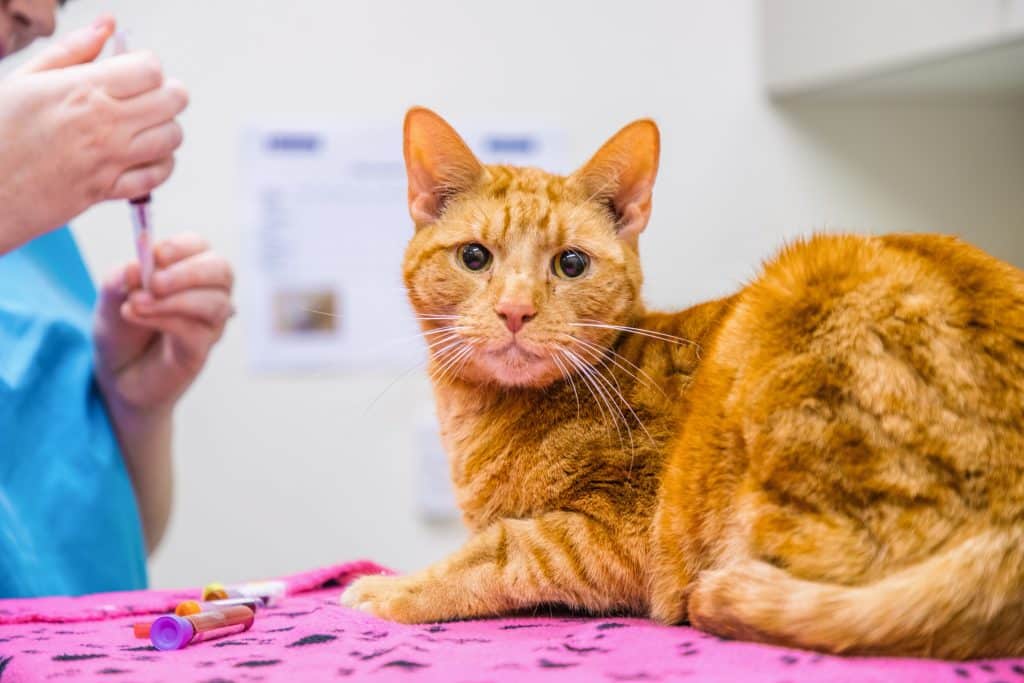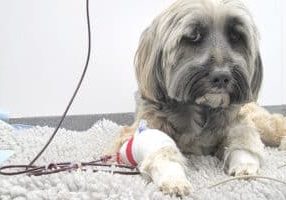
Feline infectious peritonitis (FIP) is a condition caused by feline coronavirus (FCoV). FCoV is a large, enveloped RNA virus, which is very common in cats (around 40% of the domestic cat population are seropositive, increasing to 90% in multi-cat households), and generally causes only mild intestinal signs.
In a small percentage of cats (around 10%), FCoV infection results in FIP. The factors that contribute to the development of FIP are viral, host and environmental. Regarding viral factors, mutations in the Spike protein gene (although these can also be present in non-FIP cats), the tropism of the FCoV for macrophages and its sustained replication in monocytes leading to a disseminated infection, are thought to be correlated with FIP after FCoV infection. The host immune response and the level of stress/overcrowding are also thought to contribute to the development of FIP.
What is the signalment and clinical signs?
FIP is most common in young cats (particularly those under 2 years). There is a small subset that present older than 10 years old. Male cats are over-represented, and a recent history of stress may contribute. Living in a multi-cat household increases the risk of FCoV seropositivity and pedigrees may be predisposed.
There are two main forms of FIP:
- Effusive (or ‘wet’)
- Non-effusive (or ‘dry’)
Wet FIP is present in up to 80% of FIP cases due to a vasculopathy (the effusion can be abdominal, pleural and/or pericardial).
Dry FIP is caused by the presence of granuloma formation. It is typically associated with neurological and/or ocular signs (e.g uveitis). However, there is overlap between the two forms, with cats that present with the non-effusive disease going on to develop effusions, and vice versa. Frequent non-specific clinical signs include lethargy, anorexia, weight loss as well as fluctuating pyrexia and mild jaundice. Lymphadenomegaly can also be present.
How is the diagnosis made?
A presumptive diagnosis is made by a combination of the clinical suspicion based on the signalment and clinical signs, alongside clinical pathology, imaging, and molecular diagnostic tests.
- Clinical pathology: lymphopenia (common), neutrophilia with a left shift, mild to moderate non regenerative anaemia, microcytosis (IMHA is uncommon), hyperglobulinaemia (common), with low-normal albumin and a low albumin: globulin (A: G) ratio < 0.4 (> 0.8 makes FIP unlikely) and hyperbilirubinaemia.
- Acute phase proteins (α-1 acid glycoprotein: AGP): often markedly elevated (>1.5mg/ml).
- Diagnostic imaging: effusion in body cavities, granulomas in organs, large intra-abdominal and mesenteric lymph nodes or thickening of the ileocecocolic region. MRI changes (e.g obstructive hydrocephalus, meningeal enhancement).
- Analysis of effusions: usually clear, viscous/sticky, straw yellow. It is typically pyogranulomatous (macrophages, non-degenerate neutrophils) with low cell counts of < 5 x 109 cells/L and high proteins of > 35 g/L and A:G ratio and AGP like in serum. CSF may show elevated protein concentration and increased cell counts.
- FCoV serology: A positive results indicates the exposure to FCoV. Although FIP cats tend to have higher FCoV antibody titres than non-FIP cats, there is much overlap. Also, around 10% of cats with FIP are seronegative.
- Molecular tests:
- FCoV RNA RT-PCR (not specific for FIP associated FCoV) performed in blood (not helpful due to low sensitivity), CSF, aqueous humour, effusions, or cytology of organs (the latter two are particularly helpful if high viral load and cytological features of FIP e.g pyogranulomatous)
The definitive diagnosis is only confirmed with positive immunostaining for coronavirus antigen in macrophages in formalin-fixed tissue samples. Given that obtaining tissue for histopathology may not be possible in a cat suffering FIP, demonstration of FCoV antigen by immunostaining in effusions, CSF, or cytology of aspirates from abnormal organs, in association with typical cytological features of FIP, is very supportive of a diagnosis.
Given that there are multiple other differential diagnoses for the clinical signs and clinical pathology, it is important to consider other conditions such as immune-mediated conditions (lymphocytic cholangitis), infectious diseases (toxoplasmosis, mycobacterial infection, retroviral infection, septic peritonitis, pyothorax), neoplasia (lymphoma) or others (e.g congestive heart failure or pancreatitis).
Until recently, diagnosing a cat with FIP was devastating given the lack of available curative treatment. Previously, palliative treatments have been used including corticosteroids (prednisolone at 1-2mg/kg/day, followed by tapering, for the immune-mediated component of the disease) and interferon – ω (no benefit of adding IFN – ω to corticosteroids). Recently, commercially available drugs that are showing promising results are:
- Polyprenyl immunostimulant (helps with cell mediated response). Studied in cats with non-effusive FIP (PO, three times a week). 8/60 cats survived >6.5 months. No side effects, cats without corticosteroids survived longer.
- Antiviral agents:
- Protease inhibitors (inhibit formation of viral proteins): GC376 (SC, BID). 6/20 cats alive >18 months.
- Nucleoside analogues (change the RNA of the virus to be terminated earlier)
- GS441524 (SQ, SID). Field study 24/31 cats alive > 1-2 years. In another study of 4 neurological and ocular cases 3 of 4 cats alive at 1-1.4 years.
- Remdesivir (GS-5734): is a prodrug of GS-441524. IV and SC (cannot be given orally because it has a low oral bioavailability).
The current gold standard is remdesivir (IV), followed by SC injections and finally oral GS-441524 (the duration of the treatment is 12 weeks) to avoid relapses. However, adjustments in protocols are being made and treatment may need to be modified to the individual cat and client. For example, the change from injections can be made directly (e.g after the first day or after 3-4 days).
| Summary of Dosage Recommendations and Duration of the Ideal Treatment | |||
| CLINICAL PRESENTATION | STAGE 1 – Remdesivir (IV or SC) for 2 weeks | STAGE 2 – GS441524 (oral) for 10 weeks | |
| Wet FIP (no ocular or neuro) | 10mg/kg SID | 10-12mg/kg SID | |
| Dry FIP (no ocular or neuro) | 12mg/kg SID | 10-12mg/kg SID | |
| Ocular signs (wet or dry) | 15mg/kg SID | 15mg/kg SID | |
| Neurological signs present (wet or dry) | 20mg/kg SID | 20mg/kg (divided in two doses e.g 10mg/kg BID) | |
In cats with less severe disease (eating, hydrated): treatment can start with daily remdesivir SC injections for the first 7-14 days and then swap onto daily oral GS-441524 until day 84 (week 12).
In cats with severe disease (anorexia, dehydration): treatment starts during hospitalisation, with remdesivir IV for 3-4 days (as a loading dose), followed by SC injections up to day 7-14, then swap to daily oral GS-441524 until day 84.
There are alternative treatments (less ideal, only to use if financial limitations) which include: oral only treatment protocol (GS441524 for 12 weeks) or the use of mefloquine instead of remdesivir. These are only recommended if remdesivir treatment is not tolerated or not possible financially and should be given for at least 84 days to increase likelihood of cure.
Approximate cost of remdesivir and GS441524
Costs varies significantly depending on the size and clinical presentation, but roughly a 12-week course (remdesivir and GS441524) of a 2kg kitten with neurological presentation can be around £4-5,000, whereas the same kitten with dry FIP would be around £2-3,000. Given that the tests to definitively confirm the disease are expensive, in a cat with a high suspicion of FIP, a consideration may be to attempt trial therapy, given that the improvement is usually seen in the first few days.
Possible adverse effects of remdesivir
Overall is well tolerated and safe, but potential adverse effects include:
- Local discomfort (please see below for tips on how to avoid this).
- Use a new needle each time to withdraw the drug and change the needle before injection. Use 21G for quicker administration vs 23G for better tolerance (try both).
- Use oral gabapentin (50 to 100mg per cat) or sublingual/ SC buprenorphine 30-60 min before injection. Use topical EMLA 40min before injection.
- Leave remdesivir at room temperature before administration.
- Depression or nausea a few hours after IV administration.
- Development/worsening of pleural effusion in first 48 hours (occurs 1 in 10 effusive cases treated with remdesivir)- monitor closely during first few days.
- Development of seizures (suspected to be the unmasking of subclinical CNS FIP) – treat with midazolam (0.3mg/kg IV) followed by levetiracetam (10-20mg/kg PO TID).
- Increases in ALT (unclear if due to underlying FIP or adverse drug effect) and mild peripheral eosinophilia (which may be a favourable marker for disease resolution).
Practicalities of the drugs and monitoring
- Remdesivir is kept in the fridge. GS441524 is given on an empty stomach.
- Monitor clinically (demeanour, effusions, neurological signs) and weigh cats weekly (adjust dose of drugs accordingly). Ideally also monitor serum biochemistry (or at least ALT, globulin, bilirubin) and haematology after 2 weeks of starting treatment, then monthly.
- Only stop treatment once cat is normal (clinically and on blood work) for at least 2 weeks (never stop before the 12 weeks of treatment).
- If relapse: review diagnosis, increase dose of drugs (if relapse during treatment) or restart treatment at a higher dose (if relapse after completion) and/or consider mefloquine.
Cats with FIP treated with remdesivir typically improve clinically over the first 2-3 days. The anecdotal evidence of cats treated with remdesivir and GS-441524 says that around 80-95% of cats are successfully treated. It is still too early to know how many will recur.
References:
Tasker S. Diagnosis of feline infectious peritonitis. ‘Update on evidence supportive available tests’ Journal of Feline Medicine and Surgery (2018) 20, 228–243
Tasker S. and members of the European Advisory Board for Cat Diseases. Feline Infectious Peritonitis Guidelines. 2021 http://www.abcdcatsvets.org/feline-infectious-peritonitis
Kim, Y.; Liu, H.; Galasiti Kankanamalage, A.C.; Weerasekara, S.; Hua, D.H.; Groutas, W.C.; Chang, K.O.; Pedersen, N.C. Reversal of the progression of fatal coronavirus infection in cats by a broad-spectrum coronavirus protease inhibitor. PLoS Pathog. 2016, 12, e1005531.
Pedersen, N.C.; Kim, Y.; Liu, H.; Galasiti Kankanamalage, A.C.; Eckstrand, C.; Groutas, W.C.; Bannasch, M.; Meadows, J.M.; Chang, K.O. Efficacy of a 3C-like protease inhibitor in treating various forms of acquired feline infectious peritonitis. J. Feline Med. Surg. 2018, 20, 378–392.
Murphy, B.G.; Perron, M.; Murakami, E.; Bauer, K.; Park, Y.; Eckstrand, C.; Liepnieks, M.; Pedersen, N.C. The nucleoside analog GS-441524 strongly inhibits feline infectious peritonitis (FIP) virus in tissue culture and experimental cat infection studies. Vet. Microbiol. 2018, 219, 226–233.
Pedersen, N.C.; Perron, M.; Bannasch, M.; Montgomery, E.; Murakami, E.; Liepnieks, M.; Liu, H. Efficacy, and safety of the nucleoside analog GS-441524 for treatment of cats with naturally occurring feline infectious peritonitis. J. Feline Med. Surg. 2019, 21, 271–281.
Dickinson PJ, Bannasch M, Thomasy SM, et al. Antiviral treatment using the adenosine nucleoside analogue GS-441524 in cats with clinically diagnosed neurological feline infectious peritonitis. Journal of Veterinary Internal Medicine. 2020, 34, 1587-1593.
Case Advice or Arranging a Referral
If you are a veterinary professional and would like to discuss a case with one of our team, or require pre-referral advice about a patient, please call 01883 741449. Alternatively, to refer a case, please use the online referral form
About The Discipline
Internal Medicine

Need case advice or have any questions?
If you have any questions or would like advice on a case please call our dedicated vet line on 01883 741449 and ask to speak to one of our Internal Medicine team.
Advice is freely available, even if the case cannot be referred.
Internal Medicine Team
Our Internal Medicine Team offer a caring, multi-disciplinary approach to all medical and surgical conditions.